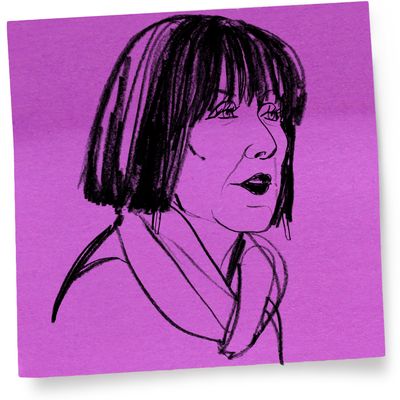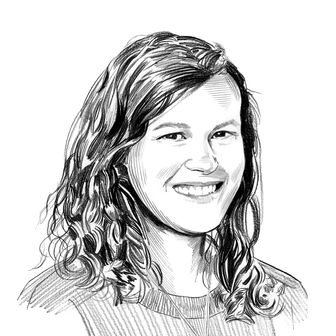
Doing the Most is a special series about ambition — how we define it, harness it, and conquer it.
Artist Marilyn Minter is best known for her paintings and photographs that explore and interrogate images of conventional female beauty: close-ups of women’s faces smeared with makeup and beads of sweat; a high-heeled foot splashing in a mud puddle. Her work, which first gained popularity in the ’90s, has been the subject of numerous solo exhibitions, including the retrospective “Marilyn Minter: Pretty/Dirty,” which appeared at the Brooklyn Museum in 2017. She’s also one of more than 400 artists featured in a new book, Great Women Artists, out this week from Phaidon, in partnership with Kering. She lives with her husband in Soho. Here’s how she gets it done.
On a typical morning:
I get up around 9:45 a.m. I usually stay up really late reading, so I go to bed around 2 a.m. My husband gets up before me and feeds the dogs, and then I get up and give them a treat. I drink my coffee and read the paper online — the Washington Post and the Times, and the Huffington Post. Then I get on the subway and commute to my painting studio on 36th Street. I stop and get an iced coffee and a cookie. I eat a lot of sugar and drink a lot of coffee, it’s terrible. But I’ve been a vegetarian for 32 years.
On organization:
I’m very organized. I have to be because I do so much activism. My inbox is pretty overwhelming. But I have an assistant who tells me, “This is what you gotta do tomorrow,” that sort of thing. She takes a lot of those emails, so I don’t have to look at them.
On her creative process:
When I’m editing [my photographs], I get in the zone. It’s a lot of fun — it doesn’t feel like work. I lose track of time. It’s not a struggle — everything just makes sense. It’s like when you’re writing, and you don’t even have to write the words, they just flow from your fingertips. That’s what I get when I’m painting, and when I’m editing. Sometimes when I’m shooting, I don’t even remember shooting it. Later I’m like, “Wow, I shot that?”
On failure:
You make a lot of things that don’t work, and you just keep narrowing it down until you get the right image. When everything’s going wrong it’s agony. My least favorite part is when I work on a painting for six months to a year and then I have to erase it and start over. I just wipe out six months of work.
If nothing’s working, I don’t beat it to death. I’ll eat lunch and then I’ll start over on something else. I don’t try to make things happen. They’re either going to flow, or I leave them alone.
On self-doubt:
I always get stressed before I start a new project. I totally feel like I’m going to fail. I’ll never get it, I don’t know what I’m doing. It’s usually right before the shoot. Who doesn’t have self-doubt? I don’t know anybody who thinks everything they do is great.
On being part of a community of artists:
When I was starting out, I knew that I was going to make a name for myself. I knew I had something to say, but nobody else thought that. Nobody. I just kept doing it anyway. Honestly, I thought, well, I like doing it so much, I don’t care if anyone sees it or not. I get enough pleasure doing it whether or not anyone else recognizes it. So that kept me going.
I also had a network of friends that I respected that admired what I was doing. That meant the world to me. I’ve always had artists friends. We’d go to each other’s studios, and if I really respected an artist and they loved my work, that made my day. It’s actually very sustaining. Think about van Gogh. He had no success during his life from the outside world, but all the artists knew he was good.
I think once in a while, if you do what you believe, the Zeitgeist comes to you. But you can’t make your work fit into the Zeitgeist. You just have to make work that you believe in, and sometimes you’re lucky and you’ll be alive when the Zeitgeist hits you.
On ambition:
I’m very ambitious. I want to keep getting better at making art, at everything. I want to get smarter, I want to get more articulate, and I want to make better decisions. I’m not satisfied. I still have a lot of curiosity and questions. I’m interested in everything. I read all the time, I go to movies. I travel a lot, and I go to museums everywhere I go. I’m lucky that I’m healthy. I don’t say, “Oh, gee, back in the day.” I find that very defeating. Back in the day for me is right now. I love today.
On activism:
Success is satisfying for a minute, but it doesn’t fill that hole. I think I get that fulfillment from activism. Right now, I’m trying to organize a shoot for a TV commercial for Planned Parenthood. I’m trying to wrangle celebrities. I’m doing it pro bono. Since 2016, I feel like I really got plunged back in. I’ve always been an activist, though. Ever since I was 16. I grew up in the South, in this really racist school system. I just found it appalling. I was mostly a marcher. I have an activist husband, too. I don’t have any trouble being motivated. I don’t think anyone does these days. Just waking up and reading the paper — if you’re not upset, you’re asleep.
On work/life balance:
I used to think that art was more important than life. Now I’m pretty sure that life is more important than art. I’m in a happy relationship, so I compromise: I spend my weekends doing whatever my husband wants to do. Usually it’s traveling. He likes to travel and I like to read, so he drives and I read.
I’m a voracious reader. I love Elena Ferrante, and Lisa Taddeo, and Sally Rooney. I’m a real biography reader. That’s one of the reasons why it’s easy to make your art even if no one pays attention to you — because if you read biographies, that’s how it was for everybody.
On competition:
Women compete with one another. I don’t believe them for a second if they say they don’t. I think that to stay healthy and not be jealous, you have to go up to people whose work you like and tell them how great it is. Just by saying it, all the poison drains out of you. You actually believe it once you say it, and then they become your colleagues and your friends. I’ve been doing it for years now, and it really works. I promote other artists all the time. I went to see Sarah Sze’s show yesterday at Tanya Bonakdar and I immediately took a video and posted it on Instagram. It’s going to change your life.
On doing the easy thing:
When I teach, I tell my students that if something comes easily to you, you should explore it. That means that’s what you should be doing. I see it all the time, a young artist says, “Oh, it comes easy, it must not be any good.” I’m constantly trying to get them to see, no, no, that’s what you’re supposed to be doing. The reason I’m so adamant about it is that I dismissed the skill I have for so long. I could draw anything — I could copy anything. And I got a lot of pleasure out of it. I figured that I couldn’t make art out of doing that. What am I gonna be, a forger? And then I figured out a way to make it work for me.
On criticism:
I ignore it, unless I think there’s something I can learn from. Most of the criticism I’ve gotten wasn’t very useful because it was mostly stupid. But sometimes there’s a kernel of truth and I try and pay attention. I listen to my friends who I trust who have constructive criticism. I have people in my life who say, “That’s a bad idea.”





